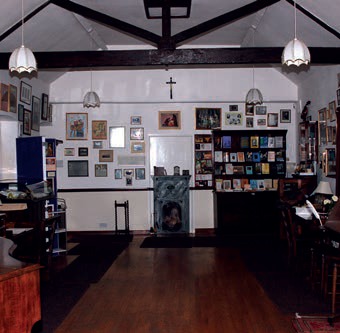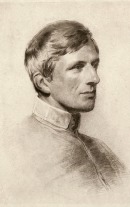
Interview: Newman’s biographer
Article:
01.09.19
Interview: Newman’s biographer
Joanna Bogle talks to Fr Ian Ker
Littlemore, Oxford, in summer sunshine. The collection of small cottage buildings that John Henry Newman acquired as a retreat, and where he was received into the Catholic Church now has a new significance. Littlemore is both a shrine to Newman and a place of study. It is run by the sisters of The Work, who welcome visitors and care for the library which houses a major collection of books by and about Newman. His chapel is preserved and Mass is said there regularly.
The garden is bathed in sunshine - green lawns, roses, and a bust of Newman. The library takes up one side: it is low-roofed and in cottage style – after Newman’s time it became for a while a scout hut before being claimed and restored.
Volumes of letters
I am here with a team from EWTN, the Catholic television network, to film an interview with Father Ian Ker, Newman biographer and expert, who has edited volumes of his letters and written extensively on aspects of his life and work. We had met a week earlier, when he was lecturing at a conference at Quarr Abbey on the Isle of Wight. His topic then was GK Chesterton, the subject of his latest biography. Today it’s Newman, and conversation turns to the link between the two: Newman’s influence on the Catholic writing of that 20th century – Chesterton, Belloc, Evelyn Waugh.
Language
“Yes, his style, his beautiful use of language – and his teaching, his clarity – these things certainly helped to foster what has been called the Golden Age of Catholic literature in England. Not sure you can always make direct inks – how influential was he on, for example, Graham Greene?”
“What is also extraordinary to think about is that today, with English as the main world language, more people are reading Newman than ever before – his influence has grown and grown. Odd to think about that: something that the British Empire never planned to achieve – an unplanned legacy from our history.”
Studying
Fr Ker talks fast and with energy, leaping up occasionally to consult a book, moving swiftly from one topic to the next, and chortling with laughter when something strikes him as funny – no stilted answers or bland statements. .
“Newman was led to the Catholic Church by studying the Fathers – going back to the sources of the Faith. That was what led him to the Church – he had never even met Catholics, didn’t know about Catholic parish life or culture. It was this desire to get to the truth of things – that was what it was all about.
“And a century later, that was what the Resourcement group – Henri de Lubac, Jean Danielou, and others, were doing – the renewal of theology that had a major influence on the Second Vatican Council. They were looking beyond the stale neo-scholasticism that had dominated teaching in the colleges in Rome and across the West, going instead to the sources.”
Second Vatican Council
“Newman has been called the Father of the Second Vatican Council and of course that’s absolutely correct – you can see a direct link between his studies and writing here in England in the 19th century, and the work of de Lubac and Danielou – and Ratzinger of course, later Benedict XVI – in the 20th.”
Fr Ker is emphatic on the subject of distortions of the Council’s teachings “The notion of the Council was taken over by a whole series of commentators with quite different agendas. There has been so much confusion. A lot of rubbish has been presented in the name of the Second Vatican Council, unconnected with the reality. You have to get past that to get to the truth.”
Movements
Much in demand as a speaker and lecturer, Fr Ker also works with the New Movements in the Church, notably the Neo-Catechumenate.
“The important thing is that these are ecclesial movements – clergy and laity together. They are certainly important for the renewal of the Church. This again is something that Newman anticipated, even back in his Anglican days when he and others could see the need for some sort of spiritual revival. He saw the Oxford Movement as just that – a Movement. Others had wanted a Committee, an Oxford-based group that would create a structure. But he never saw it like that. There was always this idea of a genuine renewal of the Church.”
Seeing links with the developments in the Church of England in the 19th century, and with the Catholic Church in the 20th and 21st obviously intrigues him. Leaping up to consult a book, riffling through the pages to find a reference, there is a sense of infectious enthusiasm. He chortles cheerfully about American groups inviting him to speak and although he has retired from parish work – he was parish priest of Burford for some years – he is evidently busy and has a full diary.
Rome
He’ll be in Rome for the canonisation and as the TV session is completed we all end up talking about that. It will be a massive event, and of lasting importance for the Church in Britain and the world. For a brief moment, as we make our goodbyes in the Littlemore garden in the late-afternoon sunshine, there is a sudden sense of awe at the oddness of things – this quiet village on the outskirts of Oxford, and its role in history. The vanished England of the 19th century, and a group of people chatting about an event that will be televised worldwide in the 21st. Newman’s tiny chapel here, and a sudden thought about a teeming St Peter’s Square, and the years that link the two, and the future of people reading Newman and invoking his prayers.
Notes:
Joanna Bogle is editor of FAITH magazine.





